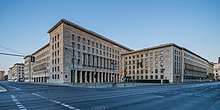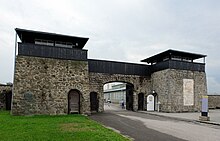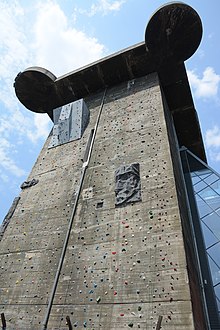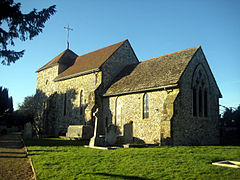나치 건축
Nazi architecture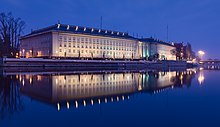
나치 건축은 1933년부터 1945년 몰락할 때까지 아돌프 히틀러와 나치 정권에 의해 추진된 건축물로 나치 독일의 도시 계획과 관련이 있다.그것은 세 가지 형태로 특징지어진다: 알버트 스피어의 디자인으로 대표되는 벗겨진 신고전주의, 전통적인 시골 건축, 특히 고산지대에서 영감을 얻은 토속적인 스타일, 그리고 주요 인프라 프로젝트와 산업 또는 군사 단지에 따른 공리주의 스타일.나치의 이데올로기는 건축에 대해 다원주의적 태도를 취했지만, 아돌프 히틀러 자신은 형태가 기능을 따른다고 믿었고 "과거의 멍청한 모방"[1]에 반대하여 글을 썼다.
고전주의와 비슷하지만, 공식적인 나치 스타일은 시청자들에게 남기는 인상으로 구별된다.건축양식은 나치에 의해 그들의 이데올로기를 전달하고 시행하기 위해 사용되었다.평평한 지붕, 수평 연장, 균일성, 그리고 장식의 부족과 같은 형식적인 요소들은 "단순함, 획일성, 기념물성, 견고성 그리고 영원의 인상"을 만들어 냈는데, 이것이 나치당이 나타나기를 원했던 [2]것이다.
애들러호스트 벙커 단지는 반쪽나무 오두막집처럼 보였다.1939년과 1940년 [3]뉘른베르크에 프랑코니아식 반목 주택 양식의 건물 7개가 지어졌다.
예를 들어 에리히 멘델손과 줄리어스 포스너는 1933년에 이민을 갔다.
강제 노동
새로운 건물의 건설은 나치 이데올로기를 재확인하는 것 이상의 다른 목적에 도움이 되었다.플로센뷔르크와 다른 곳에서, SS는 강제 노동 수용소를 건설했는데, 그곳에 있던 제3제국의 죄수들은 돌을 캐고 벽돌을 만들도록 강요받았고, 그 대부분은 베를린 재건과 독일의 다른 프로젝트에 사용하기 위해 알베르트 슈페어에게 직접 보내졌다.이 새로운 건물들은 또한 강제 노동자들에 의해 지어졌다.노동조건이 혹독해서 많은 노동자가 죽었다.이러한 광산과 건설 과정은 나치가 정치적, 경제적 목표를 동시에 달성하는 동시에 이념적 표현 [4]목표를 달성하는 건물을 만들 수 있게 했다.
웰탑슈타트 게르마니아
이 운동의 가장 큰 업적은 2차 세계대전의 나치의 승리 추정 후 독일의 수도 베를린이 재건될 것으로 예상되는 웰타우프슈타트 게르마니아였다.프로젝트를 감독한 Speer는 신도시 계획의 대부분을 작성했다.1937년에서 1943년 사이에 "세계 수도"의 극히 일부만이 건설되었다.이 계획의 핵심 특징은 베를린 전승기둥을 중심으로 동서축에 기초한 위대한 신고전주의 도시를 건설하는 것이었다.라이히스타그나 그로제 할레와 같은 주요 나치 건물들은 넓은 대로에 인접해 있을 것이다.건설 예정 구역에서 도시의 많은 역사적인 건물들이 철거되었다.하지만, 제3제국의 패배로, 그 작업은 결코 시작되지 않았다.
나치 오스트리아
대빈
대 빈은 옛 [5][6]비엔나보다 3배나 더 큰 제2의 도시였다.1942년에서 1944년 사이에 세 쌍의 콘크리트 박판 탑이 건설되었고, 그 중 하나는 하우스 데 미레스라고 알려져 있으며, 또 다른 하나는 현대 미술 창고입니다([7]현재 폐쇄되어 있습니다).
린즈
린츠는 총통 도시 중 하나였어니벨룽겐 다리만 [8]건설되었습니다.
주택 건설
나치는 많은 아파트를 지었는데, 그 중 베를린에만 10만 채가 건설되었고, 그 중 대부분은 Frenzlauer [9][10][11]Berg의 Grüne Stadt(녹색 마을)에 주택 단지로 지어졌다.폭스바겐의 도시 볼프스부르크는 원래 나치에 의해 건설되었다.
찬성자

나치 건축의 잔존 사례
- 브라운슈바이크 청소년 리더십 아카데미
- Bischofswiesen에 있는 Berchtesgaden Chancelery 지사
- 베를린 템펠호프 공항의 새로운 터미널 건물
- 베를린의 샤로텐버거 차우세이의 확대
- 베를린의 옛 라이히스뱅크 빌딩
- 뮌헨 총통
- 바이마르에 있는 가우포룸
- 뮌헨의 하우스 데 쿤스트
- 베르히테스가덴의 켈슈타인하우스
- 베를린에 있는 항공부 청사
- 뉘른베르크의 나치당 집결지
- 베를린 올림픽 경기장
- NS-Ordensburgen Krössinee, Sonthofen 및 Vogelsang
- 루겐의 프라라 빌딩 단지
- 자르브뤼켄 극장
- 폴란드 바우브르지흐에 있는 슐레지에 에렌말 묘소
- 폴란드 브로츠와프에 있는 하부 실레지안 정부 청사.
「 」를 참조해 주세요.
레퍼런스
- ^ 나치 건축, "옥스포드 건축 및 조경 건축 사전", 2006, 페이지 518.
- ^ Espe, Hartmut (1981). "Differences in the perception of national socialist and classicist architecture". Journal of Environmental Psychology. 1 (1): 33–42. doi:10.1016/s0272-4944(81)80016-3. ISSN 0272-4944.
- ^ "15. Transformer Building and Workers' Housing General Plan of the Nazi Party Rally Grounds".
- ^ Jaskot, Paul B. (2000). The architecture of oppression: the SS, forced labor and the Nazi monumental building economy. London: Routledge. ISBN 0203169654. OCLC 48137989.
- ^ "Exhibition: »Vienna. The Pearl of the Reich« Planning for Hitler".
- ^ "Vienna under the Nazi-Regime - History of Vienna".
- ^ "Vienna Luftwaffe Anti Aircraft Flak Towers today". 3 November 2017.
- ^ "The "Führer's prerogative" and the planned "Führer Museum" in Linz - Art Database".
- ^ "Der Wohnungsbau der Nazi-Zeit – Unbekanntes Erbe". 28 November 2006.
- ^ Haben, Michael (2017). Berliner Wohnungsbau 1933 – 1945 (PDF). Berlin: Gebr. Mann Verlag. ISBN 978-3-7861-2786-4.
- ^ "Grüne Stadt Michail Nelken".
참고 문헌
- Baynes, Norman H., ed. (1942). The Speeches of Adolf Hitler, April 1922–August 1939. Two vols. London: Oxford University Press.
- Brenner, Hildegard (1965). La politica culturale del nazismo [Die Kunstpolitik des Nationalsozialismus (Art policies of Nazism)] (in Italian). Translated from German by Enzo Collotti. Bari: Laterza.
- Cowdery, Ray; Cowdery, Josephine (2003). The New German Reichschancellery in Berlin 1938–1945. Victory WW2 Publishing. ISBN 978-0910667289.
- De Jaeger, Charles (1981). The Linz file: Hitler's plunder of Europe's art. Exeter: Webb & Bower. ISBN 978-0906671306.
- Dülffer, Jost; Thies, Jochen; Henke, Josef (1978). Hitlers Städte: Baupolitik Im Dritten Reich. Eine Dokumentation [Building Policies in the Third Reich] (in German). Köln: Böhlau. ISBN 3412034770.
- Giesler, Hermann (1977). Ein Anderer Hitler: Bericht Seines Architekten Erlebnisse, Gesprache, Reflexionen [A Different Hitler: Report on its Architects' Experiences, Conversations, Reflections] (in German). Druffel. ISBN 978-3806108200.
- Helmer, Stephen (1985). Hitler's Berlin: The Speer Plans for Reshaping the Central City (Illustrated). Ann Arbor: UMI Research Press. ISBN 0835716821.
- Hitler, Adolf (1971). Mein Kampf [My Struggle]. Translated by Ralph Manheim. Houghton Mifflin. ISBN 978-0395078013. 인터넷 아카이브(1941년판, 레이날 & 히치콕, 뉴욕).
- Hitler, Adolf (2000). Hitler's Table Talk 1941-1944: His Private Conversations. Translated by Norman Cameron and R.H. Stevens. New York: Enigma Books. ISBN 1929631057.
- Homze, Edward L. (1967). Foreign Labor in Nazi Germany. Princeton University Press. ISBN 0691051186.
- Jaskot, Paul B. (2000). The Architecture of Oppression: The SS, Forced Labor and the Nazi Monumental Building Economy. New York: Routledge. ISBN 978-0415223416.
- Krier, Leon (1989). Albert Speer Architecture. New York: Princeton Architectural Press. ISBN 2871430063.
- Lärmer, Karl (1975). Autobahnbau in Deutschland 1933 bis 1945 [Highway construction in Germany 1933-1945] (in German). Berlin: Akademie Verlag. ASIN B001UWP0DY.
- Lehmann-Haupt, Hellmut (1973). Art under a Dictatorship (Illustrated). New York: Octagon Books. ISBN 0374948968.
- Lehrer, Steven (2006). The Reich Chancellery and Fuhrerbunker Complex: An Illustrated History of the Seat of the Nazi Regime. McFarland & Co. ISBN 978-0786423934.
- Mittig, Hans-Ernst (2005). "Marmor der Reichskanzlei". In Bingen, Dieter; Hinz, Hans-Martin (eds.). Die Schleifung: Zerstörung und Wiederaufbau historischer Bauten in Deutschland und Polen [The Razing: Destruction and Reconstruction of Historical Buildings in Germany and Poland] (in German). Wiesbaden: Otto Harrassowitz. ISBN 3447050969.
- Nerdinger, Winfried (1999). Bauhaus-Moderne im Nationalsozialismus [Modernist Architecture in Nazi Germany] (in German). Prestel. ISBN 978-3791312699.
- Petsch, Joachim (1976). Baukunst Und Stadtplanung Im Dritten Reich: Herleitung, Bestandsaufnahme, Entwicklung, Nachfolge [Architecture and urban planning in the Third Reich: Origin, Inventory, Development, Follow-up] (in German). C. Hanser. ISBN 978-3446122796.
- Rittich, Werner (1938). Architektur und Bauplastik der Gegenwart [Plastic Figures in Modern Architecture] (in German). Berlin: Rembrandt Verlag.
- Schönberger, Angela (1981). Die Neue Reichskanzlei von Albert Speer. Zum Zusammenhang von nationalsozialistischer Ideologie und Architektur [The New Reich Chancellery by Albert Speer. To a Coherence between Nazi Ideology and Architecture] (in German). Berlin: Gebrüder Mann. ISBN 978-3786112631.
- Scobie, Alexander (1990). Hitler's State Architecture: The Impact of Classical Antiquity. College Art Association Monograph – Book 45. Pennsylvania State University Press. ISBN 978-0271006918.
- Schmitz, Matthias (1940). A Nation Builds: Contemporary German Architecture. New York: German Library of Information.
- Speer, Albert (1970). Inside the Third Reich. Translation by Richard and Clara Winston. New York: Macmillan. ISBN 002037500X. [인터넷 아카이브(Internet Archive)]에 있습니다.
- Spotts, Frederic (2002). Hitler and the Power of Aesthetics. Woodstock, New York: Overlook Press. ISBN 1585673455.
- Taylor, Robert (1974). The Word in Stone: The Role of Architecture in the National Socialist Ideology. Berkeley: University of California Press. ISBN 0520021932.
- Thies, Jochen (1976). Architekt der Weltherrschaft. Die Endziele Hitlers [Architect of world domination. The ultimate goals of Hitler] (in German). Düsseldorf: Droste. ISBN 978-3770004256.
- Zoller, Albert (1949). Hitler privat. Erlebnisbericht seiner Geheimsekretärin [Hitler's Private Secretary Testimony] (in German). Düsseldorf: Droste. ASIN B0023S7QZO.
외부 링크
- 폐허의 이론, Cornelius Holtorf는 2004년 12월 21일에 최종 갱신되었습니다.
- 홀로코스트 교사 가이드 웹사이트:
- NS-Architektur at LEMO – Lebendiges Museum Online.

